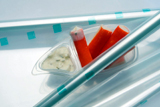The shelf life of most packaged foods is affected by oxygen
Oxidation alters value-giving ingredients and leads to quality losses such as loss of aroma substances and vitamins, formation of off-flavors, structural changes due to oxidation of proteins.
During food production, most ingredients/foods come into contact with air (containing about 21 percent oxygen), which physically dissolves in food components (water and fat). Subsequent removal of the oxygen is technically complex (evacuation, heating) and it is often not possible to remove the oxygen down to trace levels.
Task
The interaction of packaged food and oxygen is extremely complex, but needs urgent attention for quality preservation, for packaging adaptation, for correct best-before dating and for ensuring optimal storage conditions. Oxygen-depleting packaging can provide a remedy.
Application areas are MAP packaging (Modified Atmosphere Packaging), as there the compliance with the gas atmosphere is of particular importance. Since oxygen absorbers have a limited absorption capacity, they can only be used as a supplement to a barrier material. In this case, the oxygen absorber must be effectively protected from the ambient oxygen by a barrier layer to the outside. From the point of view of both the consumer and the filler, it is also important to be able to easily detect whether these so-called active packaging materials are still fulfilling their function and protecting the contents from oxygen.
Result
As part of a joint project funded by the European Commission, the Fraunhofer IVV, together with European companies from the packaging and chemical industries and two other Fraunhofer institutes (Fraunhofer ISC and IGB), has developed oxygen absorbers and indicator systems that can be incorporated into polymer composite films for food packaging.
Two oxygen absorbers and two oxygen indicators were developed. Initial pilot multilayer films with combined oxygen absorber and indicator functions were fabricated, functionally characterized, and evaluated in packaging trials for their effects on selected foods. These multilayer films extended the shelf life of oxygen-sensitive foods and, in the case of defective packaging, indicated the increased oxygen content in the packaging.
In two other projects funded by the Industrievereinigung für Lebensmitteltechnologie und Verpackung e.V. (IVLV) and the Bavarian Ministry of Economic Affairs (BayWiMi), it was shown that oxygen absorbers also provide a solution to the so-called retort shock effect. The oxygen barrier of EVOH-containing plastic composites is temporarily weakened during moist heat treatment.
Using the example of ready meals sterilized in plastic packaging, the incorporation of an oxygen absorber layer in the composite structure compensated for the retort shock weakness of EVOH and ensured the shelf life of the meals for over 9 months.
 Fraunhofer Agriculture and Food Industry Alliance
Fraunhofer Agriculture and Food Industry Alliance